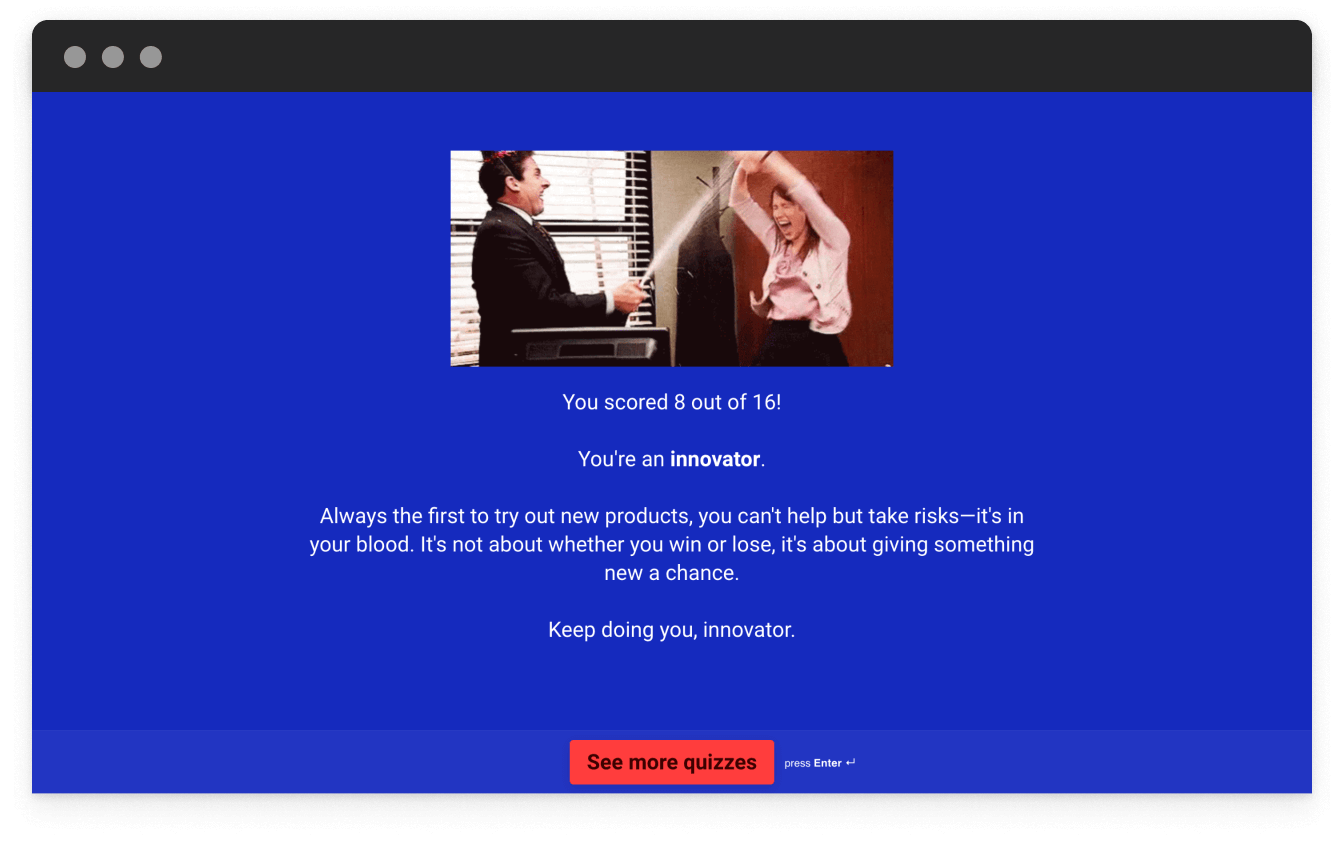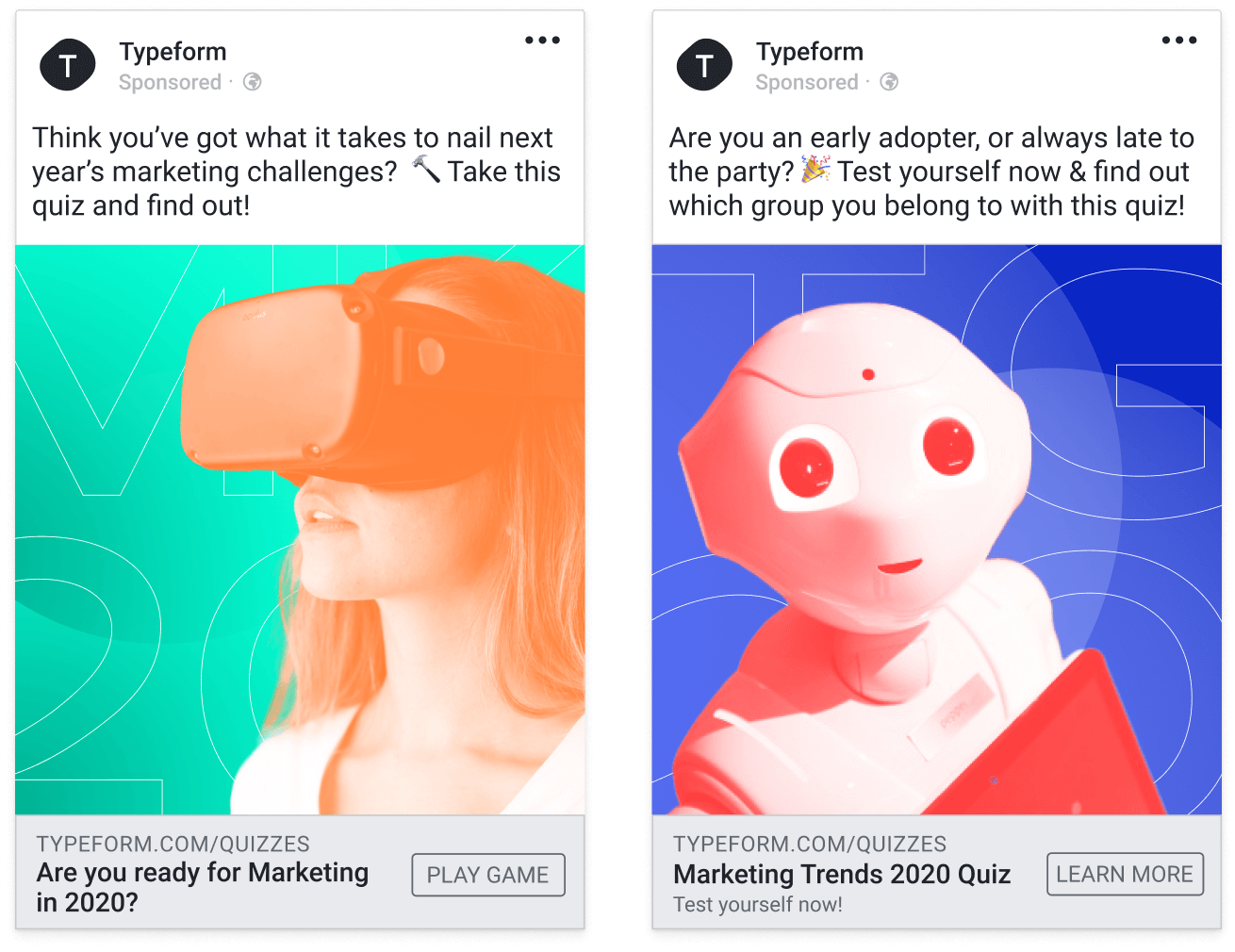7 things we learned about creating a quiz on Facebook for lead gen
An inside look at our three-week Facebook campaign for lead generation, and the quiz that helped Typeform build brand awareness.

“Dogfooding.” What’s that all about?
The first time I heard that term was last year when we, the Marketing team, were planning for the quarter. We had a company goal of promoting lead generation through quizzes, a popular use of our product. So to better understand the opportunities and pains of other marketers, we decided to go through the process ourselves. Hence, eating our own dog food.
So we created a quiz on marketing trends in 2020. You can give it a go here:
The lead gen part comes in at the end. The last question asks you to leave your email address if “you’re interested in receiving more quizzes and interactive content.”
After testing it on some colleagues and fellow marketers, we let it out into the world. We promoted the quiz through a Facebook campaign targeting four specific audiences:
- People with marketing-related job titles. Built with Facebooks’s job titles targeting option.
- People with marketing-related interests. Things like email marketing, social media marketing, marketing automation, etc.
- People interested in marketing-specific brands. Companies like HubSpot, MailChimp, and so on.
- A lookalike audience. Facebook finds users who are similar to your existing customers.
Here’s what we learned after running the campaign for three weeks.
1. Ask (for emails) and you shall receive
You know when you go to a party with zero expectations, and those nights turn out to be the best of your life? This kind of happened to us.
We made leaving an email address optional, because hey—we know how annoying it is to take a quiz, only to find out you have to leave personal info to get your results. Since the offer was quite vague—“receive more quizzes and interactive content”—we only expected a 5% response rate.
Boy, were we wrong. Out of the 2,851 users who submitted the quiz, 15% left us their email address. And all we did was ask. Now imagine what might happen if you top our proposition with a stronger offer—like a coupon, free consultation, or really good free content. Could you be looking at a submission rate of 30-40%?
Takeaway: Expose people to a fun and engaging interactive experience, and you’ll spark their interest. They might not be ready to sign up today, but they’ll remember you.
2. Make your quiz easy and beautiful—on all devices
You’re standing in the subway, checking your Facebook newsfeed and you see the perfect distraction: ‘Oh, great, a quiz! I’m going to check it out.’ You open it up only to find a big block of text filling the entire screen. Big turnoff right? I mean, would you be motivated enough to go through 10 of those novel-like questions? Exactly.
Confession: We made the same mistake with our initial version, and shortening our questions definitely helped.
So remember that not all quizzes are created the same. Just putting a quiz out there isn’t the same as offering engaging, interactive content. To be engaging:
- Keep the text concise and clear. And make sure it’s in line with your brand’s voice and tone.
- Use visuals, like images, photos, illustrations, or GIFs.
- Test it on different device views (desktop, mobile, tablet) to make sure everything displays correctly.
- Get feedback from friends, family, and colleagues. Pay attention to their reactions. Do they look confused on certain questions? Use those reactions to improve your quiz.
Takeaway: Put yourself in your respondent’s shoes. Question length, tone, humor, format, style, visuals—it all adds up to the end user’s experience. That’s what will entice them to leave their info. And that’s what they’ll remember about you.
3. Ad engagement ≠ conversions
Out of the four audiences mentioned above, the “lookalike” engaged the most with our ads—the highest click through rate and lowest cost per click.
The “marketing job titles” audience were most likely to complete the quiz, with 19% who started the quiz getting to the end. The other audiences had a click-to-quiz-submission ratio of 12%.
Why is that? Of course you can never tell for sure, but chances are high it has to do with this job-title audience being hyper-targeted. Despite its small size (150K), we knew that nearly all of these people actually worked in marketing. I say “nearly all” of these people because Facebook profiles are never 100% accurate.
The lookalike audience was much bigger (3M), so naturally there were many relevant people in that group—people working in sales, product, or other related areas. Relevant enough to be curious and start the quiz, or even leave a comment, but not relevant enough to actually complete the quiz and get their results.
Takeaway: Don’t rely on the Facebook engagement metrics to identify your most successful audience. Instead focus on downstream metrics that really matter to your business.
4. Quiz completion doesn’t mean they’re ready to sign up
Ever been on a first date so great that you blurted out " of course I' ll marry you!" ? I' m guessing that one didn' t turn out so well.
Basically, your leads are like your dates. You need to give them time. Don’t try to push them for something they' re not ready for yet.
When we launched this marketing quiz, we asked respondents the following question after completion: “What do you want to do next?” And we gave them two options:
- ' Play more quizzes' or
- ' Create a free Typeform account'
Guess what happened? 92% of the first 515 quiz-takers said they’d prefer to " get to know us" better before signing on the dotted line. After seeing the results, we removed the sign-up option altogether.
Takeaway: Take it slow, even when you see indicators of high interest. Resist pushing people down the funnel, or you might ruin your chance of establishing a real relationship and a positive association with your brand.
5. Test ad copy to set the right expectations
Have you ever clicked an ad for one thing, only to be whisked away to a landing page containing something completely different? Not an experience you want to leave with people.
To make sure we got it right, we opted for dynamic ads, meaning that Facebook optimizes your spend by pushing the best performing ad combinations. In our testing, we realized the ad that performed the best was the one with clear communication about what the user should expect at the end of the quiz.
In our case, it was a definitive answer to whether or not the respondent was an early adopter vs. late majority, or something else. On average, this ad had a 80% higher CTR and a 40% lower CPC than our other more vague ads.
Curiously, we saw similar results with the headline that contained the word “quiz” and the headline that didn’t.
Takeaway: Make it clear that you’re offering a quiz. Including the word ‘quiz’ in the headline will catch people’s attention and spark curiosity. And be upfront about what people should expect in the quiz results.
6. No lead nurturing flow? Not a problem.
Unless you work in a multi-million-dollar company with a large marketing team, you’ve probably experienced a lack of resources, or colleagues busy with other priorities. We’ve been there too.
After collecting new leads with the quiz, we wanted to connect with them as soon as possible. But our email team was slammed, so the nurturing journey we planned to create just wasn’t possible.
So we took matters into our own hands and built our own experimental lead nurturing flow, consisting of a series of three emails. This way the email team just needed to hop in at the end to connect the distribution list in our email platform. Here’s how it turned out:
Was it the best lead nurturing flow the world has ever seen? Not exactly. But hey, the emails all had an open rate between 15% and 20%, which is good considering the audience wasn’t subscribed to our product yet.
By creating the email journey ourselves, we didn’t have to postpone our campaign or risk missing our quarterly objectives. More importantly, we kept the promise we made at the end of the quiz: to deliver more quizzes and interactive content to those who are interested.
The best part of all this? We were free to experiment with the content we shared! We sent our leads additional quizzes along with a few of our top marketing-related content pieces, plus a selection of typeform templates. We also used our new product, VideoAsk, to introduce our product and show different ways that typeforms are used.
Takeaway: Be nimble and don' t let a lack of resources slow you down. You’ll get your project out of the door faster, and you might get to try on some new hats—like being an email marketer or a social media strategist for a day.
7. Research all the leads you can, even if it’s tedious work
When respondents submit a personal email address, it may limit your breadth of knowledge about the respondent. But with a work email address you can learn a lot about someone.
For the marketer pros out there, you know this can be tedious and the best way to get more from your data is to automate with specific tools. Don’t have access to special enrichment tools, or have lots of leads from smaller companies? Then you' ll have to bite the bullet and do the research manually, with the help of your good old friends: Google and LinkedIn.
Is it fun? No. At least not for me. (Reminded me of my summer holidays in Kazakhstan, where my aunt would give me and my cousins a bucket of currants each, and we had to separate the stems from the currants so she could prepare currant jam.)
Yes, it’s manual, repetitive, and time-consuming. But the reward is worth it.
We, for instance, found out that from the 100 business emails we collected, 15 were part of a company who' s already our customer, and 40 were part of a company who has been our customer at some point. We also learned 82% of our leads corresponded to our ideal customer profile criteria. Nice.
Takeaway: Learning more about your leads isn' t always straightforward—especially if they have one of those anonymous job titles that tell you absolutely nothing about what department they work in. But if you go through this hassle, you' ll be rewarded with juicy actionable insights.
Now it’s your turn. Pick a topic that your target audience will find interesting, create an engaging quiz, and test it on some guinea pigs. Then set it live, and follow up with relevant content. Happy lead-generating!
Liked that? Check these out:
.webp)
Tips
12 customer satisfaction questions that reveal real insights
Customer satisfaction surveys getting vague answers (or no answers at all)? The problem isn't your customers, it's your questions. Use these 12 CSAT questions to ask the right questions at the right time to boost response rates—and help you improve your customer experience.
Más información

Tips
14 examples of ranking survey questions to use in 2026
Get to know your customers and use their survey responses to make data-driven decisions with ranking survey questions that help you uncover more. We’ve rounded up 14 real-world examples to inspire your next survey and make creating effective ranking questions effortless.
Más información





